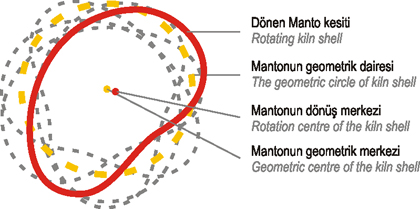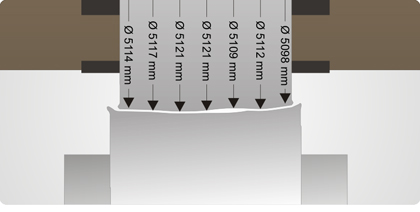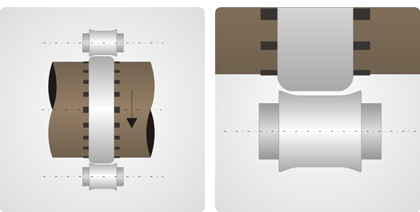The first rule of operating a rotary kiln without any problem is distributing the forces equally to each piers. This can be done best, by full contact on ring and supporter roller surfaces and minimum ovality in kiln shell.
As known; rotary kilns work in %3 – 4 slope depended on design, model and brand. This slope determines the final product’s specifications with turn speed, additive materials and thermo-conditions. A facility wants to present the best product to its customers in this formula.
There is a direct proportion between energy / staff / working hours and kiln problems. It means by the time you have more problems on rotary kilns, you need more energy to operate the kiln in normal conditions, more staff and more working hours to solve the technical problems.

It is important to take periodic measurements and analysis on the kiln and solve the problems on time to have a hassle-free kiln. Despite it seems like a huge construction, a hot rotary kiln is similar to a nylon bag full of water. The kiln stands over the supporter rollers and the shell shows oscillation because of the ring which is thicker than the shell. Ring presses the shell down and creates ovality. By the time the ovality carries itself to whole shell and creates a crank. The surface between ring and supporter roller reduces.
Local over heated places on the shell, drop downs, belts and irregular heat diffusion builds ovality on the kiln shell and this ovality carries the kiln rotation centre out of geometric centre. It is harder to measure and align an eccentric kiln. This situation creates arrhythmic contacts between ring and supporter rollers’ surfaces. So the tire and supporter rollers become more stressed and this causes over heating on surface and sides, arrhythmic pressures, yielding, cracks and failures. By the time tire and rollers become concave, convex or conical depending to the situation. The axial pressure creates waves on the surface. A kiln in this position locks itself to up and down movements.
This movement problem over heats the roller shaft beds because of the tire forcing the roller to move up or down and it is harder to align a kiln in this situation because the tire and roller machines each other and all the measurement values changes. All the alignment becomes invalid by the time.
On the other hand; tire and thrust roller contact surface problems causes poor contact and wavy structure on surfaces and irregular movements caused by waves. This situation increases the surface stress and heat-ups the roller beds. Also wrong angles on the surfaces of thrust roller and tire machines the surface and increases the problems.
Harmonic movements create timing marks on the tire surface which behaves like a gear. Geared from starts the small vibrations which will increase and wobble the whole kiln in a very short time.
Such a hassled kiln can be tamed only by following where the problem is going and early intervention by grinding (resurfacing) the tire, supporter rollers and thrust roller surfaces. Yet we cannot expect to align such a kiln for a long term use.
For carrying tire and rollers out of the problematic position, the only way is machining and grinding the surface. As a result; contact surface will increase, surface stress and connected problems will end, vibration will end, it will be possible to align the kiln for long term expectations. A hassle-free kiln will collapse down the working costs dramatically.


